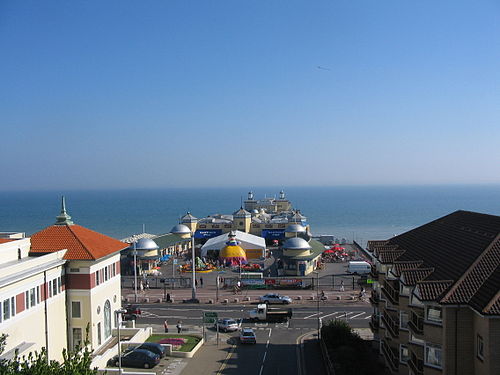Hastings Pier
Hastings Pier was a pleasure pier in Hastings, East Sussex, England. Built in 1872 and enjoying its prime in the 1930s, though becoming a popular music venue in the 1960s, it received major storm damage in 1990, closed to the public between 1999 and 2002, then closed again from 2006. Efforts continued to save the pier, which was in need of much investment. In the early hours of 5 October 2010 the pier suffered from a devastating fire (the second in its history) that destroyed 95% of its superstructure. The Hastings Pier and White Rock Trust say that, pending a structural survey, the substructure (the cast iron supports under the pier) may be salvageable. However, developers for Hastings Borough Council confirmed in an interview on 20 October 2010 that no plans had arisen as yet.
The pier has featured in many films and TV series, such as the The Dark Man, ITV wartime drama Foyle's War, which is set in Hastings. In 2009, it was featured in the music video for Ash's A-Z series single "Tracers" and Kingmaker's "Queen Jane" in 1993.
The pier was opened on 5 August 1872 by the then Lord Warden of the Cinque Ports, Earl of Granville. It was designed by Eugenius Birch, who also designed the West Pier, Brighton and Eastbourne Pier, both west of Hastings, and it is often seen as an innovative design considering the technical constraints of the late Victorian period. The pier was "constructed by a local company", while the contractors were the firm R Laidlaw & Son, Glasgow. 600 guests sat down to lunch on the pier immediately following the opening ceremony, and included the local member of parliament Thomas Brassey and Egyptian princes.
The original 2,000 seater pavilion was destroyed by fire in 1917. This was eventually replaced in 1922 and played host in the 1960s and the 1970s to notable artists such as The Rolling Stones, The Who, Jimi Hendrix, Genesis, Tom Jones, Ten Years After, and Pink Floyd. Pink Floyd founder Syd Barrett played his last ever show with the band here on 20 January 1968.
During the 1930s, the pavilion extension buildings received an art deco facelift and a theatre rebuild. This was to be its prime era.

Hastings Pier was a pleasure pier in Hastings, East Sussex, England. Built in 1872 and enjoying its prime in the 1930s, though becoming a popular music venue in the 1960s, it received major storm damage in 1990, closed to the public between 1999 and 2002, then closed again from 2006. Efforts continued to save the pier, which was in need of much investment. In the early hours of 5 October 2010 the pier suffered from a devastating fire (the second in its history) that destroyed 95% of its superstructure. The Hastings Pier and White Rock Trust say that, pending a structural survey, the substructure (the cast iron supports under the pier) may be salvageable. However, developers for Hastings Borough Council confirmed in an interview on 20 October 2010 that no plans had arisen as yet.
The pier has featured in many films and TV series, such as the The Dark Man, ITV wartime drama Foyle's War, which is set in Hastings. In 2009, it was featured in the music video for Ash's A-Z series single "Tracers" and Kingmaker's "Queen Jane" in 1993.
The pier was opened on 5 August 1872 by the then Lord Warden of the Cinque Ports, Earl of Granville. It was designed by Eugenius Birch, who also designed the West Pier, Brighton and Eastbourne Pier, both west of Hastings, and it is often seen as an innovative design considering the technical constraints of the late Victorian period. The pier was "constructed by a local company", while the contractors were the firm R Laidlaw & Son, Glasgow. 600 guests sat down to lunch on the pier immediately following the opening ceremony, and included the local member of parliament Thomas Brassey and Egyptian princes.
The original 2,000 seater pavilion was destroyed by fire in 1917. This was eventually replaced in 1922 and played host in the 1960s and the 1970s to notable artists such as The Rolling Stones, The Who, Jimi Hendrix, Genesis, Tom Jones, Ten Years After, and Pink Floyd. Pink Floyd founder Syd Barrett played his last ever show with the band here on 20 January 1968.
During the 1930s, the pavilion extension buildings received an art deco facelift and a theatre rebuild. This was to be its prime era.
20